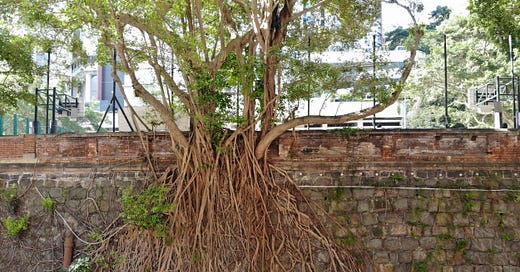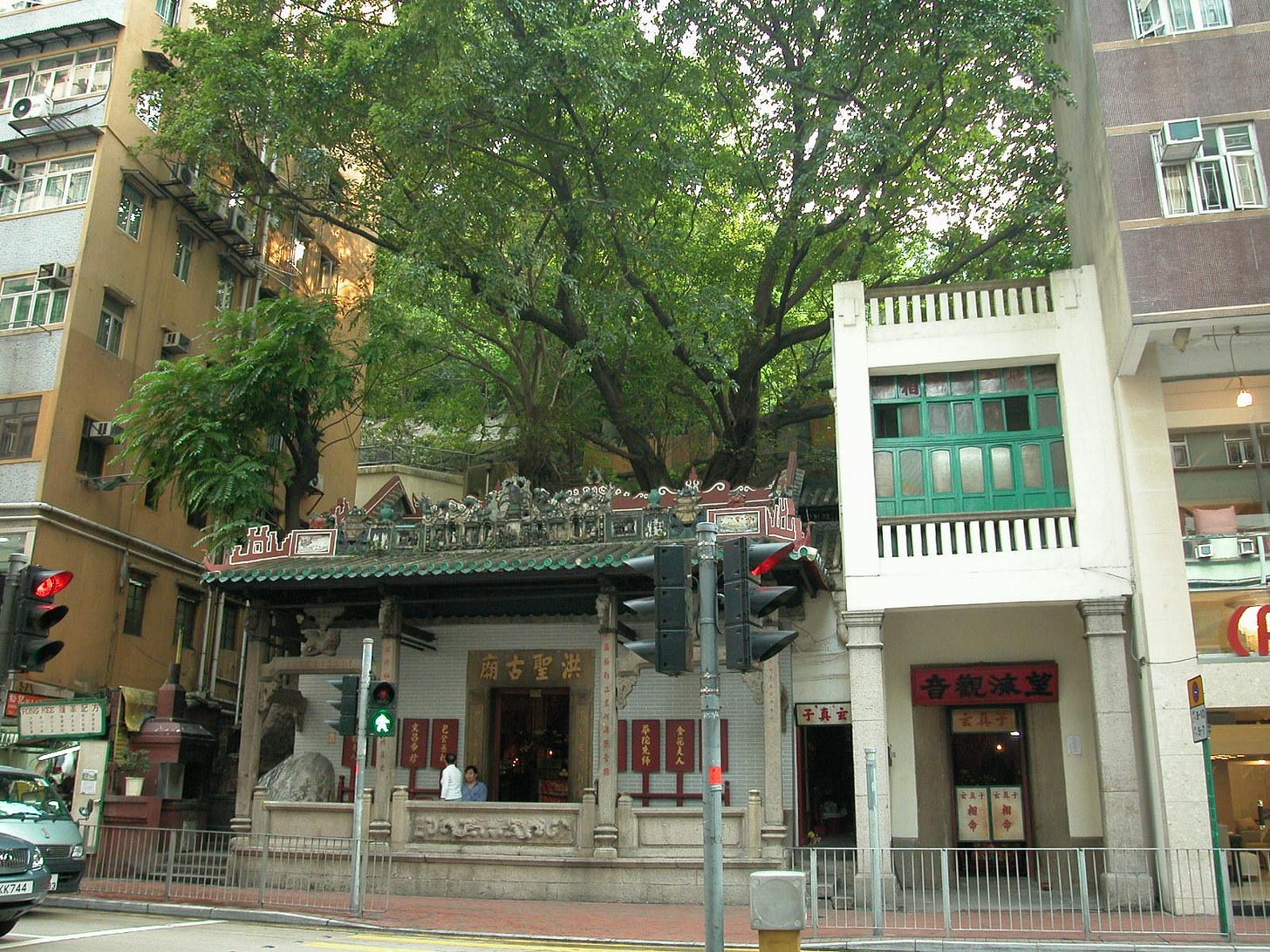Wall Trees Have The Power
Hiding amidst Hong Kong's hustle and bustle are a unique and glorious site: wall trees...
At the corner of Bowen Road and Wan Chai Gap Road on Hong Kong Island, you'll find an absolutely beautiful tree. It sits beside a waterfall and has attached itself to a wall and a bridge. It stretches over 60 feet into the sky. It's what the Conservancy Association's environmental affairs officer Martin Wan calls “a giant on the bank". It is but one example of what is known as a "wall tree", and a short walk along Bowen Road reveals several more beautiful specimens.
As the name implies, wall trees are gigantic trees, usually Chinese banyans, that have grown on top of and into masonry walls. The practice of growing trees directly into walls originates with 19th-century Guangdong Masonry workers known as the Wu Hua. "The British government had to work on the sloping in Hong Kong in order to get more flatland for development,” Wan says. "In order to do this they built many masonry walls and reclaimed more land for walls and the build-up of Victoria city, which we recognize as Kennedy Town, Wan Chai, and Central today." With the exception of a wall tree in Kowloon Park and a few in Sham Shui Po, they are only found on Hong Kong Island.
Professor C.Y. Jim, chair professor of geography at Hong Kong University, estimates that there are about 1,000 wall trees in the city. "There are 500 stone walls left and about 100 of the wall trees growing on them are particularly beautiful,” Jim says. "No other city has so many stone retaining walls and these trees. Forbes Street in Kennedy Town is widely considered to have the best specimen in the city.
It's the champion of champions. “You have to see it to appreciate its existence. Whenever I take a visitor there, they are amazed. This is nature's wonderful gift to the city.” Experts believe that there were many more wall trees around the city at one point, but development and a lack of laws steadily eroded their numbers.
Chinese banyan trees are tenacious; they can grow into sheer faces, cracks, and stone. “In ecology, this is known as spontaneous growth,” Jim says. "The trees are totally unaided by humans. Birds drop the seeds along the walls and they gradually germinate.” As for the walls, there are generally three layers. The first layer is what we can see. The second layer is rock and sand, which provide the ingredients for the trees to grow. The inner area is made up of big rocks. New walls today, despite artificial stone facades, actually consist of reinforced concrete, which means no new trees will be growing in them.
The same problem that has been steadily whittling down the city's wall trees continues today; development and a lack of legal protection endanger what Wan calls “our champion trees". Jim estimates the city has lost hundreds of wall trees over the years. The wall trees in the Tai Hang Tung district were unfortunate victims: 20 wall trees grew on both sides of the nullah, which was covered by the government. "The government has HK$1.2 billion to cover up nullahs in different parts of Hong Kong. This is a waste of money,” Jim claims. "They think the nullah is no good so they want to cover it up to give the impression of continuing development. The blue and green concept of equal planning in Hong Kong has never taken root."
Also, the stability of the walls themselves is now threatening the trees they support. “Incipient erosion is gradually causing the loss of trees and people are ignoring this,” Jim says. And it doesn't help that there are only a handful of registered tree doctors in the city. "We should have as many as possible,” Wan says. "We don't have enough professional tree doctors to trim and top the trees. Workers cut the trees so badly that they ruin their health. We have to educate more people to learn how to take care of trees.”
Look around and beautiful wall trees can be found all over Hong Kong Island. They can be seen on Robinson Road by the Mid-Levels escalator, on Bonham Road, at various locations on Kennedy Road, and bordering PMQ on the intersection of Aberdeen and Hollywood Roads. The latter has particular historical importance thanks to the building's previous incarnation as Central College, attended by Sun Yat-sen. Yet because living trees are not considered monuments, they are not protected under the Antiquities and Monuments Ordinance. "They fall between two stools,” Jim says. "There's no ordinance to protect trees. But if you protect the walls, the trees can survive. People don't realize what kind of treasure they possess and it's a pity people don't think they are valuable. There's a great need to raise awareness of this heritage. We should create statutory laws to protect them and teach people in schools what heritage is all about."
Such ordinances are in place in Taipei, Seoul, New York, and London (to name but a few cities), where there are departments and commissioners responsible for tree protection. "We don't have this,” Wan says. “In urban areas, the government can't help. For some construction sites, the Lands Department puts some conditions on the land lease, but often developers will just cut down the trees and pay the Land Department's fines.” Jim agrees that more needs to be done. "We're looking at the countryside but not the urban area,” he says. "There are several hundred champion trees left and they continue to be damaged. Nature in this city is grossly misunderstood."
10 Wall Trees to See in Hong Kong
Forbes Street, Kennedy Town: “It's the champion of champions. You have to see it to appreciate its magnificence,” says Professor Jimm. "They may be the biggest masonry walls in Hong Kong that contain wall trees,” adds Wan.
Former police quarters (currently PMQ), Hollywood Road, Central: The second-largest group of wall trees in the city has a "strong historical connection” with Sun Yat-sen.
Bonham Road, facing Center Street, Sheung Wan: "This is the biggest wall tree in Hong Kong. It's been there for more than 100 years and has survived many typhoons,” says Jim.
Ship Street, Wan Chai: “A must-see,” Wan says. "Boasts the largest masonry walls in Wan Chai.”
Queen's Road East, behind Hom Shing Temple, Wan Chai: “It's a spiritual wall tree and easy to locate,” Wan says.
Stubbs Road Park, Wan Chai: "These trees are in the list of old trees and champion trees of the LCSD. Nearly protected,” Wan says.
Bowen Road and Wan Chai Gap Road, Wan Chai: "The area is beautiful and the wall trees are on a small dam,” Wan says.
Wan Chai Park, Wan Chai: "Most wall trees are to the south of Queen's Road East, but this one is to the North,” says Wan. “It's the only evidence of wall trees we can find in the coastal area of Wan Chai. We can guess that there were more wall trees here before, but due to development they disappeared. Now there are only two left."
Bonham Road, near High Street, Sheung Wan: "There are several beautiful trees here. And let's not forget about their size too,” says Wan.
Lung Chu Street Nullah, Sham Shui Po: "This is a special case because we seldom find wall trees in a nullah,” says Wan. "In Hong Kong, the majority of the wall trees are Chinese banyan, but these are Red Stem Fig trees."








I've walked past the WanChai and other "champion trees" hundreds of times and never gave them a thought, thanks for changing that.